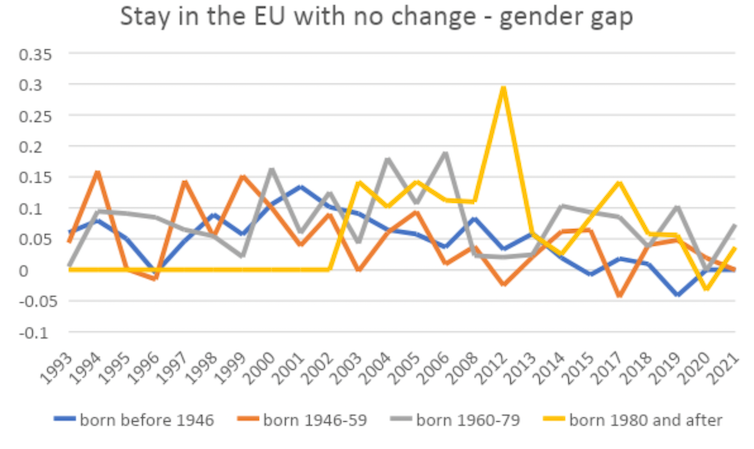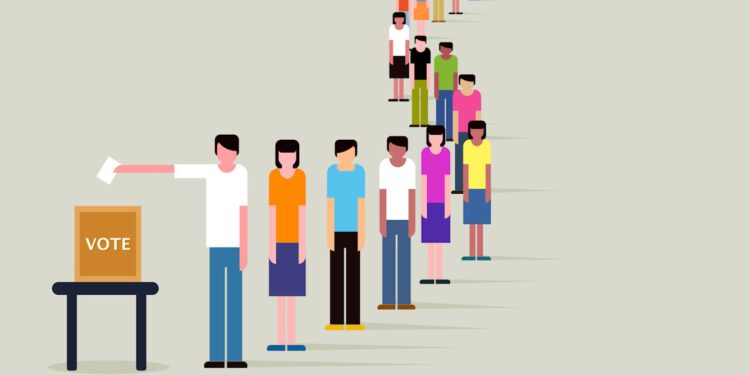Shutterstock/AJP
In many countries within the fast post-war interval, ladies have been extra typically supporters of rightwing events than males. This “conventional” gender hole was supposedly underpinned by ladies’s higher religiosity and decrease publicity to the social establishments of the left, equivalent to commerce unions.
However, in lots of rich nations, a “trendy” gender hole has emerged. Women in these nations usually tend to assist leftwing events than males. For instance within the US, a higher proportion of ladies than males have voted for the Democratic presidential candidate in each election since 1980.
When in search of to clarify why men and women vote in a different way, analysis has lengthy emphasised the position of gendered values change. This is the concept era by era, our values shift and our political leanings additionally shift to suit these new values.
But in a chapter for this 12 months’s British Social Attitudes survey, we’ve discovered that within the UK, the gender hole in voting appears extra tied to altering occasions than altering values.
Political scientists Ronald Inglehart and Pippa Norris described ladies’s leftward shift as a generational course of. In this mannequin, youthful cohorts of ladies, who’ve skilled increased labour power participation, increased schooling, and fewer conventional gender roles, turn out to be extra economically left-leaning, socially liberal and supportive of gender equality. This pushes them to the left of males of their occasion selections.
The British two-party gender hole, 1945–2019:

The share level distinction between women and men in occasion assist, with numbers under zero exhibiting ladies extra prone to vote Conservative than males and numbers above zero exhibiting the alternative.
Gallup Polls, 1945–59; British Election Study (BES), 1964–2019Adapted from P. Norris, ‘Gender: a gender era hole? (Norris 1999), CC BY-ND
That shift has solely occurred within the UK very not too long ago. Data from the British Election Study signifies that girls have been extra prone to vote for the Conservative occasion than males proper up till the 2017 basic election, once they grew to become extra prone to vote Labour than males. And we now have cause to imagine that the shift is just not as a result of ladies’s values have modified over generations.
Gender hole in partisan identification, by era, 1983-2022:

share level gender hole for various generations throughout the years.
Author offered, CC BY-ND
The British Social Attitudes survey incorporates a long-term measure of occasion identification that enables us to check underlying patterns of assist for the 2 largest events. This information gives some proof that the emergence of the fashionable gender hole in recent times is the product of underlying generational variations.
In basic, the gaps for the 2 youngest generations are typically above zero, indicating increased assist for Labour amongst ladies in these teams. And the gaps for these generations attain as much as round 15 share factors.
In distinction, the gaps for the 2 oldest generations are extra typically under zero, indicating increased assist for the Conservatives amongst ladies of those generations. The generational divide within the gender hole is especially evident from the mid-2000s onwards. Prior to this, there are fewer generational variations within the gender hole.
Did we modify – or did you?
However, whereas there’s a generational hole, it doesn’t seem like based mostly on altering values. We discover no proof that financial or social attitudes exhibit comparable gendered generational patterns.
For instance, though ladies are barely extra seemingly than males to assist increased taxation and spending on public providers, that is true throughout the generations. The gender hole itself doesn’t enhance amongst youthful cohorts.
Instead we discover that gender variations in attitudes in the direction of Britain’s membership of the EU are a doubtlessly extra highly effective clarification. Overall, ladies extra typically reported wanting to remain within the EU with no change in its powers than males. But this distinction between women and men is usually bigger and extra constant for the youthful (1960-79 and post-1980) generations than for the oldest.
So within the youthful age cohorts, a higher proportion of ladies than males have been dedicated to staying within the EU in 2017 and 2019. This might account for the emergence of the gender hole in occasion assist.
There is a distinction between women and men within the older generations on wanting to remain within the EU, however this hole tends to cut back from the mid-2000s. After 2019, there was extra convergence between the sexes throughout generations (with variations between women and men decreasing), maybe reflecting the truth that Brexit has fallen in salience.
Gender gaps in attitudes to the European Union, by era, 1983-2022:

Percentage in assist of the UK staying within the EU with no change in its powers .
British Social Attitudes, CC BY-ND
The gender hole in occasion assist that emerged within the 2017 and 2019 elections might due to this fact be the results of the interplay between electoral context, together with occasion coverage and pre-existing gender gaps in attitudes and values, such because the higher assist for the EU evident amongst youthful cohorts of ladies than males. Both campaigns have been fought round Brexit, in any case.
Our findings are in step with latest analysis that has proven that the salient political problems with the day, together with attitudes in the direction of Brexit and public providers such because the NHS, and monetary and financial issues are extra highly effective explanations of the gender hole in occasion assist than long-term values change.
This means that Labour can’t afford to be complacent about ladies voters. Their change is just not essentially a pure generational trajectory and their assist within the subsequent election is just not assured in the event that they don’t just like the occasion’s coverage positions.
![]()
Rosie Campbell receives funding from the ESRC, the UKRI, The Leverhulme Trust.
Rosalind Shorrocks receives funding from the ESRC and UKRI.
